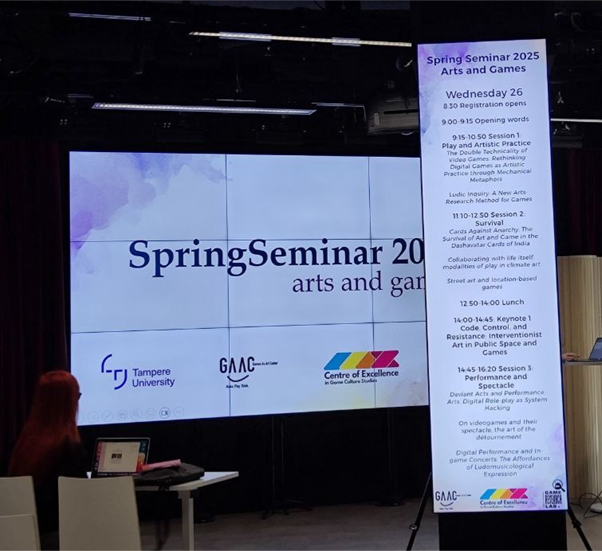By Daphne Bachmann, Juan Belío, Julius Soini, Lauri Juuti, Mun Kuan Chan, Yutong Wang, and Zoi Asterataki.
This post highlights the experiences of student volunteers at the annual Tampere University Game Research Lab’s Spring Seminar 2025, an academic event where researchers showcase their current projects and studies centered around this year’s theme – Arts and Games.
Arts and Games
This year’s seminar theme focused on the dynamic dialogue between arts and games, positioning games as powerful, active vehicles for creative expression, critical engagement, and cultural reflection. The seminar delved deep into topics such as “Play and Artistic Practice”, “Performance and Spectacle”, “Arts in Game Mechanism”, and “Overlooked Aesthetics”, offering a multifaceted view into the artistic potential of games.
Throughout the seminar, presenters investigated how games intersect with curatorial methods, historical aesthetics, and participatory culture. Games were seen not only as political tools or platforms for activism and resistance, but also as containers for underrepresented aesthetic forms, such as atmosphere. The seminar presented how games can push the boundaries of artistic expression, offering new ways of thinking about art and what it can do in this digital age.


Keynotes – Art, Activism, and Aesthetic
Like every year, two keynote speakers, Grayson Earle and Cindy Poremba, offered their critical insights related to the theme.
In Code, Control, and Resistance: Interventionist Art in Public Space and Games, Grayson Earle talked about a variety of his activist activities and games, exploring how games and digital media can be used to challenge power structures and serve as a platform for public interventions. What we found most intriguing were: Why don’t the Cops Fight Each Other?, a short documentary film about the programming of cops in GTA V and how they will attack civilians, but not other cops; and Bail Bloc, a crypto program to post bail for people. Both of these showed how playfulness, technology, and critique can be interconnected and used for change.

Cindy Poremba’s keynote, Capture Matters: Games, Art, and Real Images, explored the critical and aesthetic implications of incorporating real-world imagery into game environments. What we found inspiring was how the Prince of Persia movement were rotoscoped from videos of the creator’s younger brother to animations, for example, or about in-game photography to show how matter is not just captured or created but hybridized.
Intersections of Art and Game Studies
Manifestation of this will to explore the relationship between games and art coalesced in the research presented by our various speakers, as the reaches of both fields coincided in original and intriguing ways. From the overlap of street art in Barcelona and the preservation of art through Pokéstops (Mauricio Castro Valdez & Jorge Ruiz-Cabrejos) to the remediation of miniature gaming through the “28 movement“ (Aasa Timonen), scholars were sure to include all sorts of games in an exploration of their artistic value past the overdone question “Are games art?”, and into how their nature as art reveals new concepts.

From virtual concerts happening through games as platforms (Karina Moritzen), what videogame level design can tell us about art installations (Kitty Clark), to how the darker tactics of football are being ruined with the advancement of surveillance technology (Olli Sotamaa & Chris Paul), this seminar shined for its variety and the commitment of the presenting authors to its themes.
Socials!
The first evening of the seminar ended with a casual social gathering held in the Lyhty building on Tampere University’s City Center Campus. A good number of guests and speakers joined the gathering and most stayed until the end, a sure sign of a pleasant and enjoyable atmosphere.
The space offered a variety of activities to help attendees unwind after the day’s long sessions. Guests were invited to try their hands on various board games, piece jigsaw puzzles (which were ambitiously solved within a three-hour window, no less!), and some even took part in a round of Werewolf. That said, most were perceivably more enticed by the variety of snacks, beverages and deep conversations with fellow students and scholars present.
Following another full day of thought-provoking talks and sharing, the Spring seminar has finally come to an end – but the fun did not just end there. Guests and speakers were invited to a guided tour at the Finnish Museum of Games at Vapriikki. Here, all attendees were introduced to various exhibitions in the museum, including the history of digital games, traditional board games, and role-playing games.
Last but not least, how could all hungry scholars and guests not spend a well-deserved celebratory dinner at Plevna, a perfect way to mark the end of another successful year of insightful and inspirational exchange, community, and play?
On Volunteering
As in previous years, we, again, had a handful of volunteers supporting the preparations for this year’s seminar. Being a volunteer, while it includes a lot of running around, is also a good opportunity in many ways for a student to build connections and see a specific side of academic life. There was ample time between mic-running, coffee brewing, and holding up the reception to listen to the talks and engage in conversations with the researchers in attendance.
Naturally, events like these often come with their fair share of behind-the-scenes moments. This year included the traditional stretching schedules of the talks, a few technical hiccups, as well as a misalignment of a coffee machine, with spillage that ensued. The fact that none of us volunteers really needed to stress over the hiccups speaks volume about the general vibe of the Game Research Lab’s Spring seminar – the researchers might be people you look up to, but the mood was jovial and people approachable.
